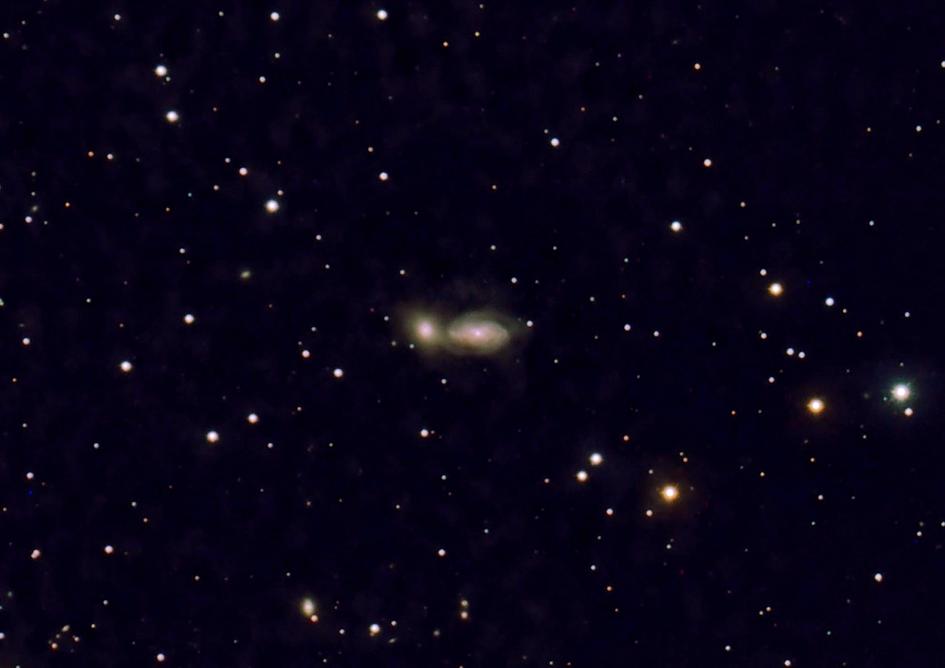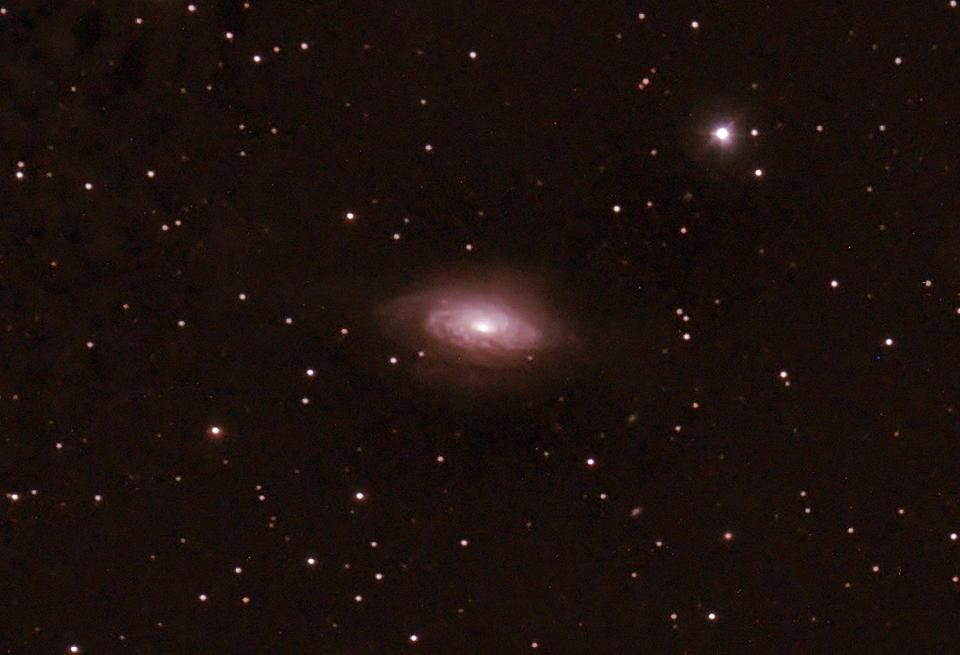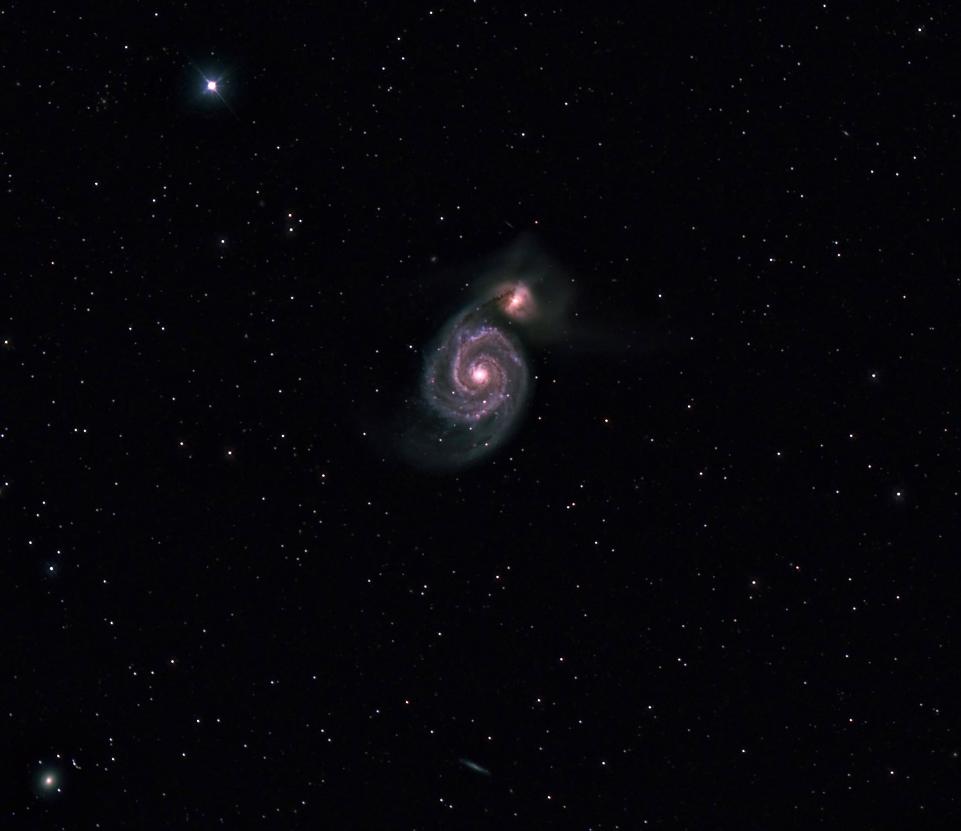| LATEST IMAGES FROM LAND OF OZ OBSERVATORY |
The following series of images were captured on the evening of April 20th, 2020, just 1 day before new moon.
It was an exceptional night for imaging: very cool, low humidity, no wind, and SQM-L readings of 21.6 or better.
The first image was captured before 10 p.m., and the last series of images was completed at 4:00 a.m. It was a
very productive night!
It was an exceptional night for imaging: very cool, low humidity, no wind, and SQM-L readings of 21.6 or better.
The first image was captured before 10 p.m., and the last series of images was completed at 4:00 a.m. It was a
very productive night!

The NGC-3166 galaxy group in Sextans: This group of three galaxies lie in the constellation of Sextans, just southwest of Regulus (A Leonis).
The two brightens members of the group, NGC-3166 (the brightest galaxy in the center of the group) is gravitationally interacting with NGC-3169
to the north. The faintest member of the trio, NGC-3165 lies just south of 3166. Another small edge-on galaxy, NGC-3156, lies just right of the
bottom center of the image. These galaxies lie about 70 million light years from Earth.
NOTE: This image is an integration of six 6-minute exposures through the C-11 at f/2 using HyperStar and the ZWO ASI 071MC camera.
Guided, captured and combined using Maxim DL 5 Pro. Post processed using PhotoShop CS2.
The two brightens members of the group, NGC-3166 (the brightest galaxy in the center of the group) is gravitationally interacting with NGC-3169
to the north. The faintest member of the trio, NGC-3165 lies just south of 3166. Another small edge-on galaxy, NGC-3156, lies just right of the
bottom center of the image. These galaxies lie about 70 million light years from Earth.
NOTE: This image is an integration of six 6-minute exposures through the C-11 at f/2 using HyperStar and the ZWO ASI 071MC camera.
Guided, captured and combined using Maxim DL 5 Pro. Post processed using PhotoShop CS2.

NGC-3226 and 3227: An interacting pair of galaxies in Leo, located less than 1 degree due east of the bright double star Gamma Leonis. NGC-3227,
to the right, is a 12th magnitude intermediate spiral galaxy that is gravitationally interacting with the nearby dwarf elliptical galaxy NGC-3226. This
pair lies at a distance of 50 million light years from Earth. The gravitational interaction is pulling a string of stars and gas from NGC-3226, and is
causing a burst of star formation in the nearest spiral arm of NGC-3227. The small elliptical galaxy NGC-3222 is visible near the bottom center of image.
NOTE: This image is an integration of eight 6 minute exposures through the C-11 at f/2 using HyperStar and the ZWO ASI 071MC camera.
Guided, captured and combined using Maxim DL5 Pro. Post processed using PhotoShop CS2.
to the right, is a 12th magnitude intermediate spiral galaxy that is gravitationally interacting with the nearby dwarf elliptical galaxy NGC-3226. This
pair lies at a distance of 50 million light years from Earth. The gravitational interaction is pulling a string of stars and gas from NGC-3226, and is
causing a burst of star formation in the nearest spiral arm of NGC-3227. The small elliptical galaxy NGC-3222 is visible near the bottom center of image.
NOTE: This image is an integration of eight 6 minute exposures through the C-11 at f/2 using HyperStar and the ZWO ASI 071MC camera.
Guided, captured and combined using Maxim DL5 Pro. Post processed using PhotoShop CS2.
NGC-3521: A large spiral galaxy located in the southern part of the constellation of Leo. This galaxy lies 26 million light years from Earth. The morpho-
logical classification of NGC-3521 is SABbc, which indicates a spiral galaxy with a trace of a central bar, and loosely would arm structure. The outer arms
are patchy and irregular, giving it a flocculent appearance. The massive central nucleus is dominated by redder, older stars, which results in the "warm"
appearance of the galaxy in this image.
NOTE: This image is an integration of five 6-minute exposures through the C-11 at f/2 using HyperStar and the ZWO ASI 071MC camera.
Guided, captured and combined using Maxim DL5 Pro. Post processed using PhotoShop CS2.
logical classification of NGC-3521 is SABbc, which indicates a spiral galaxy with a trace of a central bar, and loosely would arm structure. The outer arms
are patchy and irregular, giving it a flocculent appearance. The massive central nucleus is dominated by redder, older stars, which results in the "warm"
appearance of the galaxy in this image.
NOTE: This image is an integration of five 6-minute exposures through the C-11 at f/2 using HyperStar and the ZWO ASI 071MC camera.
Guided, captured and combined using Maxim DL5 Pro. Post processed using PhotoShop CS2.

GALAXY FIELD IN VIRGO: This lovely image is centered on the fine edge-on spiral galaxy NGC-4216 near the center of the Virgo cluster of galaxies,
and truly gives a feeling of peering into deep space. There are over 15 galaxies in this image. The brightest are NGC-4222, north of 4216, NGC-4206
to the south, elliptical NGC-4193 at the left bottom of the image, and face-on NGC-4189 at the lower LH edge of the image. These are all part of the
main Virgo Cluster of Galaxies, which lie roughly 55 million light years from Earth.
NOTE: This is an integration of six 6-minute exposures through the C-11 at f/2 using HyperStar and the ZWO ASI 071 MC camera.
Guided, captured and combined using Maxim DL5 Pro. Post processed using PhotoShop CS2.
and truly gives a feeling of peering into deep space. There are over 15 galaxies in this image. The brightest are NGC-4222, north of 4216, NGC-4206
to the south, elliptical NGC-4193 at the left bottom of the image, and face-on NGC-4189 at the lower LH edge of the image. These are all part of the
main Virgo Cluster of Galaxies, which lie roughly 55 million light years from Earth.
NOTE: This is an integration of six 6-minute exposures through the C-11 at f/2 using HyperStar and the ZWO ASI 071 MC camera.
Guided, captured and combined using Maxim DL5 Pro. Post processed using PhotoShop CS2.
NGC-4485/4490: An interactive pair of galaxies in Canes Venatici. The larger galaxy, 4490, is a barred spiral. NGC-4485 is a dwarf elliptical galaxy.
The gravitational interaction between them is causing intense star-formation activity in 4490. These galaxies have already had their closest approach,
and are now pulling away from each other, causing a string of stars and gas to be drawn away from NGC-4490. This pair lies at a distance of 25
million light years from Earth.
NOTE: This image is an integration of five 6-minute exposures through the C-11 at f/2, using HyperStar and the ZWO ASI 071MC camera.
Guided, captured and combined using Maxim DL5 Pro. Post processed using PhotoShop CS2.
The gravitational interaction between them is causing intense star-formation activity in 4490. These galaxies have already had their closest approach,
and are now pulling away from each other, causing a string of stars and gas to be drawn away from NGC-4490. This pair lies at a distance of 25
million light years from Earth.
NOTE: This image is an integration of five 6-minute exposures through the C-11 at f/2, using HyperStar and the ZWO ASI 071MC camera.
Guided, captured and combined using Maxim DL5 Pro. Post processed using PhotoShop CS2.

INTERACTING GALAXIES IN CANES VENATICI: This interesting field includes three galaxies that have interacted with each other in the recent past,
and may still be doing so. The large galaxy at the left is NGC-4631, a distorted edge-on spiral galaxy that is interacting with its small dwarf elliptical
companion NGC-4627. The large galaxy to the right is NGC-4656, sometimes called the "Hockey Stick" or "Crowbar" galaxy. It is distorted due to a
past interaction with NGC-4631. This group of galaxies lie at a distance of approximately 25 million light years from Earth.
NOTE: This image is an integration of five 6-minute exposures through the C-11 at f/2 using HyperStar and the ZWO ASI 071MC camera.
Guided, captured and combined using Maxim DL5 Pro. Post processed using PhotoShop CS2.
and may still be doing so. The large galaxy at the left is NGC-4631, a distorted edge-on spiral galaxy that is interacting with its small dwarf elliptical
companion NGC-4627. The large galaxy to the right is NGC-4656, sometimes called the "Hockey Stick" or "Crowbar" galaxy. It is distorted due to a
past interaction with NGC-4631. This group of galaxies lie at a distance of approximately 25 million light years from Earth.
NOTE: This image is an integration of five 6-minute exposures through the C-11 at f/2 using HyperStar and the ZWO ASI 071MC camera.
Guided, captured and combined using Maxim DL5 Pro. Post processed using PhotoShop CS2.


Galaxy M-101 and companions: This image was captured on the evening of May 30th, 2020, just after first quarter moon. The imaging was begun at
midnight, with the moon just about to set in the west. This is an integration of twenty-three 3 minute exposures through the C-11 at f/2 using HyperStar
and the ZWO ASI071 MC CMOS camera. Also shown in the image are 3 companion galaxies, NGC-5474 (right edge) NGC-5473 (north of M-101) and
NGC-5422 (edge-on, at LH edge).
NOTE: Guided, captured & combined using Maxim DL5. Post processed using PhotoShop CS2, Astronomy Tools, GradientXTerminator & NoiseWare.
midnight, with the moon just about to set in the west. This is an integration of twenty-three 3 minute exposures through the C-11 at f/2 using HyperStar
and the ZWO ASI071 MC CMOS camera. Also shown in the image are 3 companion galaxies, NGC-5474 (right edge) NGC-5473 (north of M-101) and
NGC-5422 (edge-on, at LH edge).
NOTE: Guided, captured & combined using Maxim DL5. Post processed using PhotoShop CS2, Astronomy Tools, GradientXTerminator & NoiseWare.
M-51, THE "WHIRLPOOL" GALAXY: Located just beneath the handle of the Big Dipper, this magnificent spiral galaxy lies 35 million light years
from Earth. This was the first galaxy that was visually observed to have spiral arms, by Lord Rosse with his 72-inch reflecting telescope in 1845.
Also seen in this image, directly below M-51, is the small edge-on galaxy NGC-5169.
NOTE: This image acquired on June 14, 2020 is an 84 minute integration of 4-minute sub-exposures through the Celestron 11" SCT at f/2 using
HyperStar and the Starlight Express SXVR H694C camera. Guided, captured and combined using Maxim DL5. Post processed in PhotoShop CS.
from Earth. This was the first galaxy that was visually observed to have spiral arms, by Lord Rosse with his 72-inch reflecting telescope in 1845.
Also seen in this image, directly below M-51, is the small edge-on galaxy NGC-5169.
NOTE: This image acquired on June 14, 2020 is an 84 minute integration of 4-minute sub-exposures through the Celestron 11" SCT at f/2 using
HyperStar and the Starlight Express SXVR H694C camera. Guided, captured and combined using Maxim DL5. Post processed in PhotoShop CS.



NGC-7293, Commonly called THE HELIX NEBULA: This is one of the nearest and brightest of the Planetary Nebulae in our galaxy.
It lies less than 700 light years away, in the constellation of Aquarius. Visually, this object appears over half the size of a full moon.
NOTE: This image was acquired on the morning of August 18, 2020, and is a 1 hour 52 minute integration of 4-minute sub exposures
through the C-11 at f/2, using the SXVR-H694C CCD Camera. Guided, captured and combined using Maxim DL5 Pro. Post processed
using PhotoShop CS2, levels, curves, Gradient XTerminator, StarShrink and NoiseWare.
It lies less than 700 light years away, in the constellation of Aquarius. Visually, this object appears over half the size of a full moon.
NOTE: This image was acquired on the morning of August 18, 2020, and is a 1 hour 52 minute integration of 4-minute sub exposures
through the C-11 at f/2, using the SXVR-H694C CCD Camera. Guided, captured and combined using Maxim DL5 Pro. Post processed
using PhotoShop CS2, levels, curves, Gradient XTerminator, StarShrink and NoiseWare.